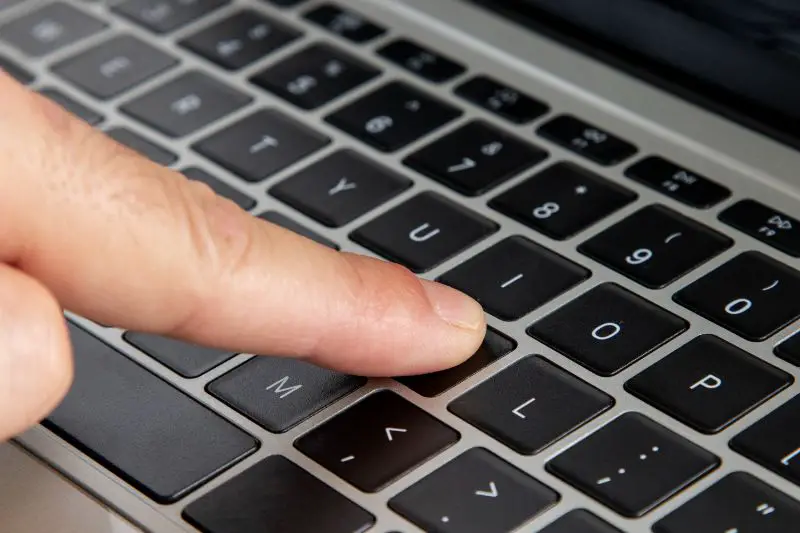
When the keyboard on a Dell laptop stops working, it can be an incredibly frustrating experience. There are many different underlying causes that could be preventing your keyboard from functioning normally. Some of the most common causes include hardware issues, outdated drivers, or a locked keyboard.
Content of the page
Common causes of a non-functional Dell laptop keyboard

- Hardware issues – Over time, certain hardware components of a laptop can wear down or become damaged, resulting in a malfunctioning keyboard.
- Outdated drivers – If the drivers that control the keyboard are out of date, they may not be able to communicate properly with the laptop.
- Locked keyboard – If the keyboard has been locked, the keys may be unable to respond to input.
Identifying specific keyboard issues
In order to properly diagnose and repair a non-functional Dell laptop keyboard, it is important to first determine what is causing the issue. Depending on the cause of the malfunction, the methods of repair may vary.
Hardware issues – One of the most common causes of a malfunctioning laptop keyboard is a hardware failure. When a hardware issue occurs, certain components of the laptop may become damaged or worn down, resulting in a malfunctioning keyboard. To determine if a hardware issue is causing the problem, it is important to check the laptop’s keyboard for any physical damage or wear and tear.
Outdated drivers – If the keyboard drivers are out of date, they may not be able to communicate properly with the laptop. To check if the drivers are causing the issue, it is important to make sure that the drivers are up to date.
Locked keyboard – If the keyboard has been locked, the keys may be unable to respond to input. To determine if this is the cause of the issue, it is important to check the keyboard settings to ensure that the keyboard is not locked.
Quick Fixes and Basic Solutions

If your Dell laptop keyboard is not working, there are several steps you can take to troubleshoot and repair the issue.
| Solution | Description |
|---|---|
| Restarting the laptop | Resets settings or processes causing the keyboard issue |
| Checking for obstructions | Inspecting and removing physical obstructions or debris from the keyboard |
| Ensuring the keyboard is not locked | Verifying keyboard settings to confirm it’s not locked |
| Updating or reinstalling drivers | Checking and updating or reinstalling outdated keyboard drivers |
| Running the keyboard troubleshooter | Utilizing the keyboard troubleshooter to identify and resolve keyboard issues |
Restarting the laptop
One of the first things you should do when troubleshooting a malfunctioning keyboard is to restart the laptop. This can help to reset any settings or processes that may be causing the issue.
Checking for physical obstructions or debris
If the laptop has been exposed to liquid or debris, it is important to check the keyboard for any physical obstructions or debris. If any debris or obstructions are present, they should be removed.
Ensuring the keyboard is not locked
If the keyboard has been locked, the keys may be unable to respond to input. To check if the keyboard is locked, it is important to check the keyboard settings to ensure that the keyboard is not locked.
Updating or reinstalling keyboard drivers
If the keyboard drivers are out of date, they may not be able to communicate properly with the laptop. To check if the drivers are causing the issue, it is important to make sure that the drivers are up to date. If the drivers are outdated, they should be updated or reinstalled.
Running the keyboard troubleshooter
If none of the above steps have resolved the issue, it may be necessary to run the keyboard troubleshooter. The troubleshooter can help to identify any issues with the keyboard and provide solutions to resolve the issue.
Advanced Troubleshooting

| Step | Description |
|---|---|
| Checking keyboard settings in BIOS | Checking if the keyboard is enabled or disabled and verifying correct language settings in the BIOS |
| Performing a system restore | Restoring laptop software and settings to an earlier point in time to fix the keyboard issue |
| Scanning for malware or viruses | Performing regular scans to detect and remove malicious software affecting the keyboard |
| Disabling third-party keyboard-related software | Disabling programs that may interfere with the keyboard operation |
| Performing a clean boot | Identifying programs causing keyboard problems by performing a clean boot |
Checking keyboard settings in BIOS
If your Dell laptop’s keyboard is not working, the first step in troubleshooting the issue is to check the settings in the Basic Input/Output System (BIOS). In the BIOS, you can check if the keyboard is enabled or disabled, and make sure that the language settings are correct. To access the BIOS, restart your laptop and press the F2 or Del key on your keyboard when the Dell logo appears.
Performing a system restore
If the keyboard settings in the BIOS are correct but your keyboard is still not working, you can try performing a system restore. This will restore your laptop’s software and settings to an earlier point in time, and may help fix the keyboard issue. To perform a system restore, go to the Control Panel, click on System and Security, select System, and then click System Protection.
Scanning for malware or viruses
Malware or viruses can cause your laptop’s keyboard to malfunction, so it is important to perform regular scans for any malicious software. You can use your laptop’s built-in security software, or you can download anti-virus and anti-malware programs from the internet.
Disabling third-party keyboard-related software
Third-party software can sometimes interfere with your keyboard, so it is a good idea to disable any programs that are related to your keyboard. To do this, go to the Control Panel, click on Programs and Features, and then disable any programs that are related to your keyboard.
Performing a clean boot
Performing a clean boot can help you identify programs that may be causing problems with your keyboard. To perform a clean boot, go to the Control Panel, click on System and Security, select System, and then click Advanced System Settings. Then, click on the Advanced tab, and click on the Settings button in the Startup and Recovery section.
Hardware Related Issues
| Issue | Description |
|---|---|
| Checking the keyboard connection | Verifying secure connection and ensuring no loose wires between keyboard and laptop |
| Replacing the keyboard | Consider replacing the keyboard if the connection is secure but it still doesn’t work |
| Testing the keyboard on another device | Checking the keyboard on a different device to confirm if the issue is with the keyboard itself |
Checking the keyboard connection
If the keyboard settings and software are correct, the issue may be a hardware issue. First, check the connection between the keyboard and the laptop. Make sure that the keyboard is securely connected to the laptop and that there are no loose wires.
Replacing the keyboard
If the connection is secure but the keyboard is still not working, you may need to replace the keyboard. You can purchase a replacement keyboard from Dell or from a third-party retailer.
Testing the keyboard on another device
If you have access to another laptop or desktop computer, you can test the keyboard on the other device to make sure that the issue is not with the keyboard itself.
Additional Tips and Recommendations

Using an external keyboard
If your laptop’s keyboard is not working, you can use an external keyboard. External keyboards are inexpensive and can be purchased from most electronics stores.
Keeping the keyboard clean and well-maintained
It is important to keep your laptop’s keyboard clean and well-maintained. Make sure to clean any dust or debris off the keys regularly, and check for any signs of wear and tear.
Updating the laptop’s BIOS and drivers
Outdated BIOS and drivers can cause problems with your laptop’s keyboard, so make sure to update them regularly. You can use your laptop’s built-in update utility, or you can download updates from the Dell website.
Contacting Dell support
If none of the above steps have helped, you may need to contact Dell support for further assistance. Dell support can provide additional tips and advice on troubleshooting your laptop’s keyboard.
Conclusion
If your Dell laptop’s keyboard is not working, there are several steps you can take to troubleshoot the issue. First, check the settings in the BIOS, and make sure the language settings are correct. You can also try performing a system restore, scanning for malware or viruses, and disabling third-party keyboard-related software. If the issue is hardware related, check the connection between the keyboard and the laptop, replace the keyboard, or test the keyboard on another device. You can also use an external keyboard, keep the keyboard clean and well-maintained, update the laptop’s BIOS and drivers, and contact Dell support for further assistance.
